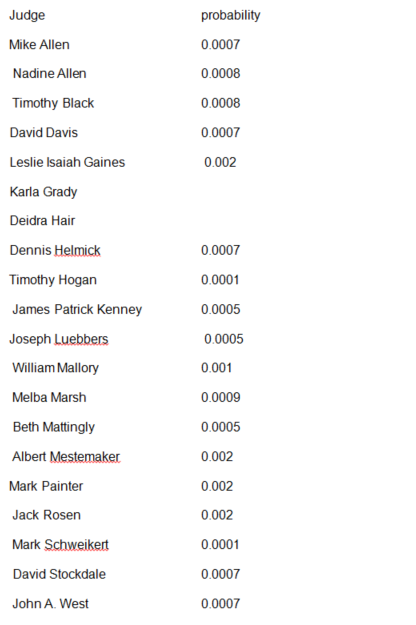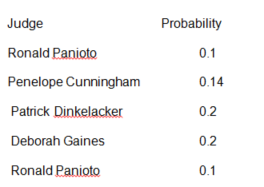Probability acts as essential tool in determining the performance of individuals. In this case, the performance of judges in three categories of courts can be determined by applying probability analysis, which considers the total cases conducted by each judge, the number of appeals, and reversed cases.
Probability of Cases being appealed and reversed
Common plea courts
- Total number of appeals =1762
- Total numbers of reversal is 199
- Probability= (199/1762)100=11.29% or 0.1129
- Domestic relations court
- Total numbers of appeals=106
- Total number of reversals=17
- Probability= (17/106)100=16.04% or 0.1604
Municipal court
- Total numbers of appeal=500
- Total numbers of reversals=104
- Probability= (104/500)100=20.80% or 0.2080
Probability of a case being appealed for each judge
The Formulae is a total number of appeals divided by the total number of cases (Anderson, Sweeney &Williams, 2012).
Common plea courts

Domestic relation courts

Municipal courts

Probability of a case being reversed for each judge
The general formulae is total reversed cases divided by total cases (Anderson, Sweeney &Williams,2012).
Common plea courts

Domestic relation courts

Municipal courts

Reversal on appeal given to each judge
General formulae is a total number of reversals divided by the total number of appeals for each judge (Anderson, Sweeney &Williams,2012).
Common plea courts

Domestic relation courts

Municipal courts

Ranking judges on the basis of the quality of their services
Ranking of judges started from the best performing to those who make many mistakes. The probability of reversal given an appeal for each judge was considered. Those with the lowest probability value were considered as high performing judges(Anderson, Sweeney &Williams,2012).
Common plea courts

Domestic relation courts

Municipal courts

From the probability results based on different categories, it is easier to determine performance of judges based on the appealed cases and the reversed cases. Through probability analysis, the performance of judges can be ranked from highly performing ones to those who make mistakes when giving their verdict (Anderson, Sweeney &Williams,2012).
Reference
Anderson, D.R., Sweeney, D.J., & Williams, T.A. (2012). Essentials of statistics for business and economics. South-Western Cengage Learning.